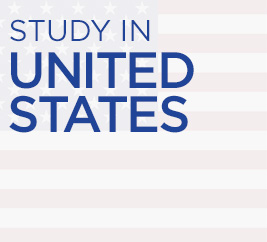
The United States of America needs no introduction. For years, United States has been the land of opportunities. It’s a country that is not only a pioneer in technological innovation and scientific exploration, but is also highly regarded for its motion picture industry, and art and architecture.
American Universities are melting pots of diverse cultures, with the spectrum spread over more than 60 countries. The United States has one of the world’s finest university systems, with outstanding programs in virtually all fields. At the undergraduate level, excellent programs exist in traditional disciplines, as well as in professional fields. At the graduate level, students have the opportunity to work directly with some of the finest minds in their field of study, with the chance to become involved with exclusive research and educational opportunities. U.S. degrees are recognised throughout the world for their excellence.
American degrees are highly regarded world over and give a cutting-edge advantage to an individual while applying for a job. Climate varies considerably across the United States. You will probably need an umbrella, even in Las Vegas or Los Angeles. In the northern cities you will need cold weather and snow gear. In the southern states, summers may be very hot and the winters mild. Depending on the part of the country, temperatures during the summer will run from the 70s through the 90s.

- The United States of America has been a global leader in the field of education, setting standards for the quality of faculty, research and the generic experience a student is opened up to when studying overseas
- There is a breadth of knowledge in a diverse range of subjects, especially for aspiring leaders of the future
- The networking experience and the learning gained during the time spent at a US institution help you on the path towards excellence and eventually success
- The diversity of modules, top quality faculty and the overall student cultural enhancement, their commitment to excellence remains evident in the most objective of measures, i.e. the World University Rankings, where over 40 Universities in the World Top 100 are in the United States
- Wide variety of programs for selection
- Opportunity for Research, Teaching and Training
- Variety of Educational Opportunities
Diversity offers students options to specialize in a variety of academic disciplines and even gain employment training. More than 4,500 accredited institutions make up U.S. higher education in the United States. Unlike many countries, U.S. higher education institutions are not centrally organized or managed, but are accredited on a national or regional level by independent accrediting bodies.
A variety of institution types offer higher-education degrees. Liberal arts institutions, for example, offer courses in the arts, humanities, languages, and social and physical sciences. The majority of liberal arts institutions are private. Private colleges and universities are funded by a combination of endowments, gifts from alumni, research grants, and tuition fees. Private colleges and universities are usually smaller than public institutions and can have a religious affiliation or be single-sex schools.
Community colleges are another option and provide two-year associate degree programs to prepare students to continue studies for an undergraduate degree or help them gain occupational skills for immediate employment. State colleges and universities, also called “public universities”, were founded and subsidized by U.S. state governments to provide a low-cost education to residents of that state. Public universities generally offer access to research opportunities and classes in a wide variety of fields of study. These universities tend to be very large and generally admit a wider range of students than private universities. Each student’s interests will guide his/her choice among the many possibilities.
Regardless of the institution type, in the United States, students typically earn credits for courses they take and these credits count towards the completion of a program. Courses are often divided into “core” subject areas to provide the foundation of the degree program and “major” courses to provide specialization in a subject area. Students can also take “elective” courses to explore other topics of interest for a well-rounded educational experience.
*Bachelor’s Degree – 4 years
*Master’s Degree – 2 years
Admission requirements vary based on the course that student is applying to and also the high school or University curriculum the student is currently studying.
**Registered students with Gyanberry are provided with detailed admission requirements as well as comprehensive guidance on the entire admission process.
a) Minimum AED 40,000 – Maximum AED 100,000 per academic year
Living Expenses: Approx. AED 30,000 – AED 40,000 per academic year
Part Time Work: Yes, Possible
Post Study – Work Visa: Yes
- Students are permitted to work 20 hours per week on-campus during the first years of study. In the second-year students can take part-time jobs or co-op/internships off campus to full fill academic or financial requirements
- The on-campus jobs do not pay much and certainly not enough to finance a university education. This kind of jobs can only be a supplement to other funds
- Along with the acceptability and recognition of education, USA also offers the best in terms of future job prospects and immigration possibilities after studies
- All students are entitled to stay back and work for one-year period in USA under OPT (Optional Professional Training). For STEM Graduates (Science, Technology, Engineering and Mathematics) the OPT can be further extended to another 24 months (Total 36 Months). Students who are successful in finding a suitable placement can apply for H1B (Job Visa) during this period
WHAT OUR STUDENTS HAVE TO SAY ABOUT US

















































